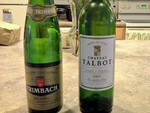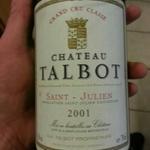This past Saturday night, my fiancée and I sat down to enjoy the Patriots-Colts game, in style. Rather than choosing to enjoy traditional football fare as we cheered the Patriots on to victory, we decided to be a little fancier, and a little healthier. So, instead of loading up on pizza, chicken wings, and other snacks, we took a trip to Guild Fine Meats, and stocked up on oysters and a roast chicken for our gametime enjoyment. And of course, I was prepared to enjoy a few good wines during the game.
We enjoyed the oysters during the first half with a bottle of 2003 Trimbach Cuvée Frédéric Emile, a tremendous Riesling from Alsace. Oysters are becoming a new passion of mine, and after a rough first attempt at shucking them where I put a nasty gash into my left hand, I've become quite proficient at preparing a plate of oysters. (I've also bought an oyster glove.) Shucking oysters, my new culinary passion. As my obsession with oysters has developed, I've noticed that they demonstrate a terroir in a manner similar to wine. The oysters we enjoyed on Saturday were Thatch Island Oysters, from Barnstable Harbor, in Cape Cod. I'm still enough of an oyster novice that I probably couldn't tell the difference between a Thatch Island Oyster and a Wellfleet, or a Bluepoint, but I'm excited to test my palate, and learn more about oysters in the years to come. (Note: For anyone who might also be interested in learning about oysters, I was given a great book for Christmas, called A Geography of Oysters, by Rowan Jacobsen, which has been a tremendous resource in my oyster education thus far.)
Shucking oysters, my new culinary passion. As my obsession with oysters has developed, I've noticed that they demonstrate a terroir in a manner similar to wine. The oysters we enjoyed on Saturday were Thatch Island Oysters, from Barnstable Harbor, in Cape Cod. I'm still enough of an oyster novice that I probably couldn't tell the difference between a Thatch Island Oyster and a Wellfleet, or a Bluepoint, but I'm excited to test my palate, and learn more about oysters in the years to come. (Note: For anyone who might also be interested in learning about oysters, I was given a great book for Christmas, called A Geography of Oysters, by Rowan Jacobsen, which has been a tremendous resource in my oyster education thus far.)
However, despite my love for oysters, and delicious flavors of petrol, honeyed mineral, and citrus displayed by the 2003 Trimbach Cuvée Frédéric Emile, it was a bottle of 2001 Chateau Talbot that left me awestruck on Saturday night. Midway through the 3rd quarter, as we were finishing our last glasses of Riesling, and beginning to eat our roast chicken, I asked my fiancée what type of red she would like to drink with the meal. "A Cabernet, from France," she replied decisively.
 Good wines to accompany good food, and a Patriots playoff win.I had already personally decided that I wanted to open an older vintage, preferrably a 2001 or 2003, to honor one of the two past great Patriots teams that this year's team reminds me of. When my fiancée suggested a Cabernet Sauvignon from France, I was left with little choice but to open my 2001 Chateau Talbot. My wine collection isn't stocked with much Bordeaux, and while I wouldn't ordinarily open such an expensive wine on a whim, the Patriots' stellar performance, the good company, and the good food made me think that there probably would be no better occassion to open it in the future. "Besides," I thought to myself. "It probably is reaching peak maturity anyways. It won't continue to mature for much longer."
Good wines to accompany good food, and a Patriots playoff win.I had already personally decided that I wanted to open an older vintage, preferrably a 2001 or 2003, to honor one of the two past great Patriots teams that this year's team reminds me of. When my fiancée suggested a Cabernet Sauvignon from France, I was left with little choice but to open my 2001 Chateau Talbot. My wine collection isn't stocked with much Bordeaux, and while I wouldn't ordinarily open such an expensive wine on a whim, the Patriots' stellar performance, the good company, and the good food made me think that there probably would be no better occassion to open it in the future. "Besides," I thought to myself. "It probably is reaching peak maturity anyways. It won't continue to mature for much longer."
Upon opening the bottle, my thoughts about the bottle's lack of longevity could not have been proven to be more off base. The wine was still an inky dark purple as I poured it into the glass. There was not even a hint of brickish red around the edges of the wine, which I found shocking for a wine that was entering its 13th year of life. The aromas and flavors were still primary, with vibrant red and black fruit flavors, mixed with hints of cedar. The wine was silky and pure on the palate, with perfectly integrated tannins. It was one of the better wines I've had in a long time.
As I mentioned earlier, I don't own much in the way of Bordeaux. I generally shy away from the region because I 2001 Chateau Talbot find it relatively unexciting. The region is dominated by corporations, and the best wines are so outlandishly priced that anyone not earning a seven figure salary would have to make a signficant financial sacrifice to enjoy a single bottle. In recent years, the prices for the wines from Bordeaux's five first-growth estates (Chateaux Lafite-Rothschild, Mouton-Rothschild, Latour, Haut-Brion, and Margaux) have pushed into the thousands of dollars per bottle, despite total production volumes approaching or exceeding 10,000 cases per year. In short, most Bordeaux represents the antithesis of the small production, family estate wines which I so passionately advocate for on a regular basis. However, this bottle of 2001 Chateau Talbot was a reminder of why Bordeaux has such a passionate following among wine conoisseurs. It has a tremendous capacity for aging, and the best wines of the region can be tremendous. There are bargains to be found in Bordeaux, and if you can afford to sample any of the region's premier wines, you certainly won't be lacking for quality wine on your table.
2001 Chateau Talbot find it relatively unexciting. The region is dominated by corporations, and the best wines are so outlandishly priced that anyone not earning a seven figure salary would have to make a signficant financial sacrifice to enjoy a single bottle. In recent years, the prices for the wines from Bordeaux's five first-growth estates (Chateaux Lafite-Rothschild, Mouton-Rothschild, Latour, Haut-Brion, and Margaux) have pushed into the thousands of dollars per bottle, despite total production volumes approaching or exceeding 10,000 cases per year. In short, most Bordeaux represents the antithesis of the small production, family estate wines which I so passionately advocate for on a regular basis. However, this bottle of 2001 Chateau Talbot was a reminder of why Bordeaux has such a passionate following among wine conoisseurs. It has a tremendous capacity for aging, and the best wines of the region can be tremendous. There are bargains to be found in Bordeaux, and if you can afford to sample any of the region's premier wines, you certainly won't be lacking for quality wine on your table.
Despite the fact that many of the region's top chateaux are owned by corporations, and many wines are made on an industrial scale, there are small family estates in Bordeaux, as well as larger estates that adhere to artisan winemaking techniques. I found it comforting to learn that although Chateau Talbot is the owner of one of the largest tracts of land under vine in all of Bordeaux, the estate still employs a practice of harvesting all of its grapes by hand each year. At the end of the day, I suppose it doesn't matter how large an estate becomes, if it is able to scale its artisan winemaking practices accordingly. It certainly showed through in the bottle I enjoyed this Saturday.